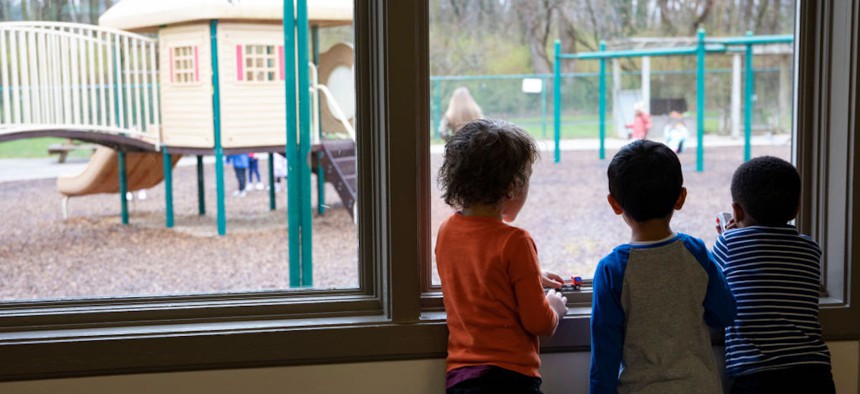Connecting state and local government leaders
The end of federal child care subsidies will impact states differently depending on how they used the money and if they plan to spend their own.
As the end of federal child care subsidies approached, advocacy groups and think tanks this summer began warning of a child care cliff. The money, approved as part of the 2021 American Rescue Plan Act, had been helping prop up the child care industry by paying providers’ rent, lowering tuition rates and increasing wages for workers.
Researchers estimated in June that with the end of funding on Sept. 30, as many as 3.2 million children could lose their daycare spots as roughly 70,000 programs closed and 232,000 caregivers lost their jobs, according to the left-leaning Century Foundation.
But according to state child care agencies contacted by Route Fifty, the impacts will vary widely around the country with officials in many states like Tennessee, Minnesota and the District of Columbia saying they will be spending hundreds of millions to soften the blow.
Still, advocates are pressing Congress to appropriate billions for child care in the next spending budget because several states are not using their own money to make up for the loss.
“I think it's unrealistic to think that taking that much money out of the system is not going to have some impact,” said Patricia Cole, senior director of federal policy at the advocacy group ZERO TO THREE.
Indeed, officials in Wisconsin say the programs that have been helping child care providers in their state will now end after lawmakers there decided not to replace federal funding. Wisconsin had received $357 million of the $24 billion allocated by Congress under the Child Care Stabilization Grants program. The U.S. Department of Health and Human Services says the money has gone to more than 220,000 child care programs to serve 9.6 million children.
One factor in why the impact will vary widely is that states used the money in different ways.
A spokesperson for the Arkansas Department of Education, for example, said that because the state knew the funding was only temporary, it encouraged providers to use the money for “one-time projects, such as improving facilities.” As a result, the spokesperson said, “the expiration of funds won’t have a dramatic impact on providers in Arkansas.”
But that’s not how many of the states approached the funding, according to a separate analysis by ZERO TO THREE and The Center for Law and Social Policy. Several states used the money to help child care providers keep operating, raise workers’ pay, lower tuition costs for low-income parents and provide other services like mental health counseling.
The study by the Center for Law and Social Policy found that in Louisiana, Michigan, New York, and Virginia, the federal dollars helped nearly 30,000 child care programs that serve more than 1.4 million children stay open, said Rachel Wilensky, the think tank’s senior policy analyst.
Laura Valle-Gutierrez, a fellow with The Century Foundation and a co-author of the June analysis, says there has been “good news” since the study was released.
“Alaska, Minnesota and Vermont have all put in additional state funding to fill this gap,” she said, “so they'll likely see fewer than one-third of programs closing.”
Valle-Gutierrez said the think tank is working on updating its estimates of what the end of the federal dollars will mean given that many states are increasing spending on child care. But she still argues that federal funding is needed.
Some States Have Approved Funding for Child Care
At least 18 states have increased spending on child care this year, according to an analysis by Child Care Aware of America.
Tennessee is one of those states. Last week, it announced that it will be increasing reimbursement rates for child care providers and will be giving those in areas considered “child care deserts” an additional 15% in funding.
Under legislation passed by the Minnesota Legislature this year, the state will increase the rates child care providers are paid beginning on Oct. 30. Funding to help lower-income people pay for child care will grow by $30 million over the next biennium, which will increase access to child care for approximately 500 more families or 1,000 children. Another $316 million over the next biennium will provide grants to child care providers to increase the pay of their workers, “moving this workforce closer to a livable wage,” according to a state Department of Human Services fact sheet.
The funding is meant to address the fact that child care workers make a median of $13.96 per hour, which the fact sheet says is “lower than the cost of living, making it difficult to recruit and retain qualified people.” As a result, 10% of child care jobs are vacant, which is higher than other professions that provide care, resulting in a quarter of the state’s young children living in “areas severely lacking child care.”
“While the federally funded Child Care Stabilization Grants have ended, significant investments in child care will fill some of those [gaps],” said Spenser Bickett, a spokesperson for the Minnesota Department of Human Services.
The West Virginia Department of Health and Human Resources, meanwhile, has sent $101 million in ARPA funds directly to providers and spent $101 million on a child care subsidy program. When the ARPA funds began running out in May, the state used $24 million in Temporary Assistance for Needy Families to continue paying the higher reimbursement rates through next August. For that reason, the states doesn’t anticipate “a significant change in the number of providers due to the expiration of ARPA funding,” said Jessica Holstein, a spokesperson for the department.
Some Cities Have Also Approved Funding for Child Care
In the district, an education department spokesperson said an initiative by the city council would ease some of the impact of the loss of federal funding. The city spent $70 million last year to pay workers four payments of up to $3,500 each between October 2022 and September 2023. This year, the program will give funding to child care providers who agree to pay workers a minimum salary.
“We are confident that these resources, combined with the ingenuity and expertise of our incredible early childhood program leaders and staff, will enable our child care sector to continue to operate and meet the needs of children and families going forward,” said Fred Lewis, a spokesperson for the district’s state superintendent of education.
In Richmond, Virginia, Mayor Levar Stoney is pushing a referendum on the city’s November ballot that would allow the construction of a casino and divert $19 million of gaming tax revenue to a child care trust fund. The money would be used to lower the cost of child care for children under 5 to no more than 10% of a family’s income. The funds would raise the pay of city child care workers and provide grants for new child care ventures.
“I think for a lot of lawmakers and leaders around the country, it scares us,” Stoney, chairman of the U.S. Conference of Mayors’ Health and Human Services Committee, said in an interview. “This has been a lifeline for a lot of families, and with a cliff upon us, a lot of families are going to have to make some tough decisions.”
More Federal Funding in Doubt
Despite those efforts, advocates like Wilensky of the Center for Law and Social Policy and Cole of ZERO TO THREE are pushing for the $16 billion in funding proposed last month by a number of Democrats, including Washington Sen. Patty Murray, the chairwoman of the Senate Committee on Appropriations.
However, the prospects of additional funding coming is in question. President Joe Biden and Congress agreed not to increase overall spending next year as part of June’s deal to avert a default on the nation’s debt.
Murray was able to get a $700 million increase included in the bipartisan spending proposal passed by the Senate’s appropriations committee in July. Cole called the proposal “heroic” given the limits placed by the debt ceiling deal, but added that it’s “still not enough.”
House Republicans, meanwhile, have said they will seek to decrease overall spending next year.
Without federal funding, several state programs will cease.
Gina Paige, a spokesperson for the Wisconsin Department of Children and Families, said that as a result of federal funding ending, not only will its child care subsidy program end but so will others that the state expanded with the federal dollars.
Among them, she said, is a pilot project that has helped parents find and pay for child care for children with disabilities and developmental delays, and a program that provides mental health consultants to child care providers.
The Utah Department of Workplace Services said that nearly half of child care providers in the state have received federal funding. But like Arkansas, they were aware that “it was one-time funding and they would need to plan as to how to respond after the funding expires,” said Christina Davis, spokesperson for the department.
Davis said the state does not expect half of its child care providers to close as The Century Foundation report estimated. But, she said, “we know that providers will experience impacts.”
In arguing for more federal funding, advocates argue that the ARPA funding was never enough to deal with the longstanding issues with the child care industry.
“Congress decided to step in to keep this really vital sector afloat with the pandemic relief,” Wilensky said. “The resources were able to save the sector from total collapse. But they were really never intended to solve the deep-rooted and systemic problems that have always been present in the child care sector.”
Kery Murakami is a senior reporter for Route Fifty, covering Congress and federal policy. He can be reached at kmurakami@govexec.com. Follow @Kery_Murakami

NEXT STORY: If jobs won’t bring people downtown to work, what will?




